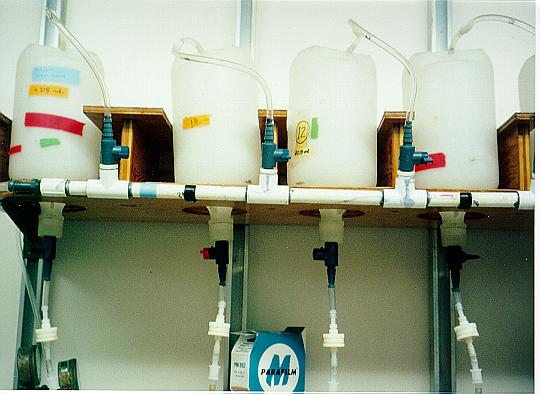|
Hawaii Ocean Time-series (HOT)
in the School of Ocean and Earth Science and Technology at the University of Hawai'i at Manoa |
|
| » Home » Analytical Results » HPLC Pigments | |||||||||||||||||||||||||||||||||||||||||||
Sampling ProcedureChlorophyll a and photosynthetic accessory pigments were measured by high performance liquid chromatography (HPLC) according to Wright et al. (1991). The response factors yielded by this method during 2022 are presented in the Table below. Figure 46 shows the relationship between chlorophyll a measured by fluorometry and chlorophyll a measured by HPLC during 2022.
ResultsContour plots of HPLC-determined pigment concentrations from 0-200 dbar during 1988-2022 are shown in Figures 47-49. The pigments have been segregated into three chromophore classes: chlorophylls (chlorophyll a, chlorophyll b, and chlorophyll c; Figure 47), photosynthetic carotenoids (19'-butanoyloxyfucoxanthin, fucoxanthin, and 19'-hexanoyloxyfucoxanthin; Figure 48) and photo-protective carotenoids (diadinoxanthin, zeaxanthin, and α+β-carotene; Figure 49). Chlorophyll a includes contributions by monovinyl and divinyl chlorophyll a and serves as a proxy for phytoplankton community biomass. Chlorophyll b includes contributions by monovinyl and divinyl chlorophyll b and is primarily derived from Prochlorococcus spp. since chlorophyll b-containing eukaryotes (e.g., chlorophytes and prasinophytes) are relatively rare at Station ALOHA as evidenced by the low and variable concentrations of lutein (chlorophyte marker) and prasinoxanthin (prasinoxanthin marker) (data not shown). Chlorophyll c includes contributions by chlorophylls c1+c2+c3 and serves as a proxy for chromophyte microalgal biomass (e.g., haptophytes, pelagophytes and diatoms). Photosynthetic carotenoids are typically useful for distinguishing phytoplankton at the Class level and the dominant species found at Station ALOHA include 19'-butanoyloxyfucoxanthin (pelagophyte marker), fucoxanthin (diatom marker), and 19'-hexanoyloxyfucoxanthin (haptophyte marker). The photo-protective carotenoids, diadinoxanthin, zeaxanthin, and α+β-carotene are respectively associated with chromophyte microalgae, cyanobacteria (e.g., Prochlorococcus, Synechococcus and Trichodesmium spp.), and all members of the phytoplankton community. Pigment distributions display distinct temporal patterns at Station ALOHA, with highest pelagophyte abundances during the periods 1989-1991 and 1996-2006. For other key groups, such as the haptophytes and cyanobacteria, there appears to be a recent post-1996 enhancement in their biomass relative to the previous 7-year period of observation. Diatoms, on the other hand, display sharp increases during the summer months of certain years (e.g., 1998 and 2000). These interannual variations in phytoplankton populations are likely linked to climate forcing (e.g., ENSO and PDO) and are currently under investigation. | |||||||||||||||||||||||||||||||||||||||||||


